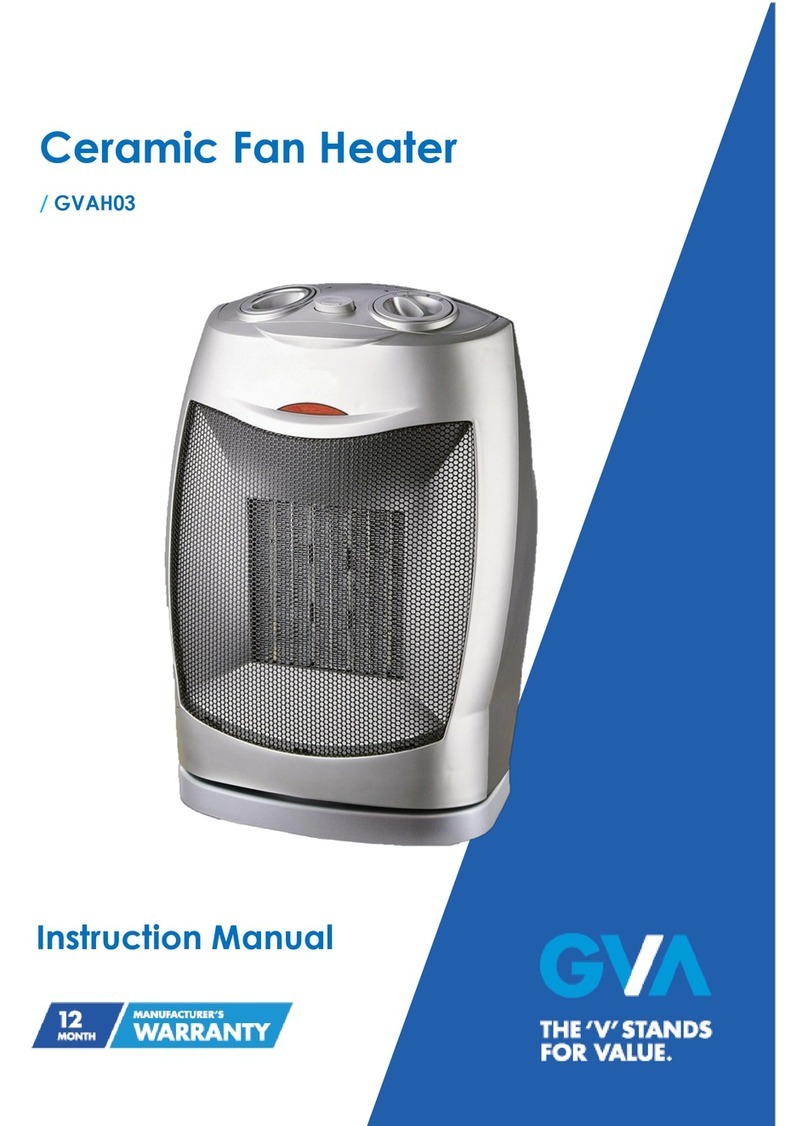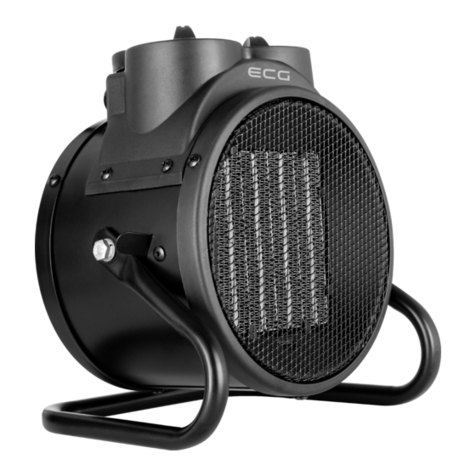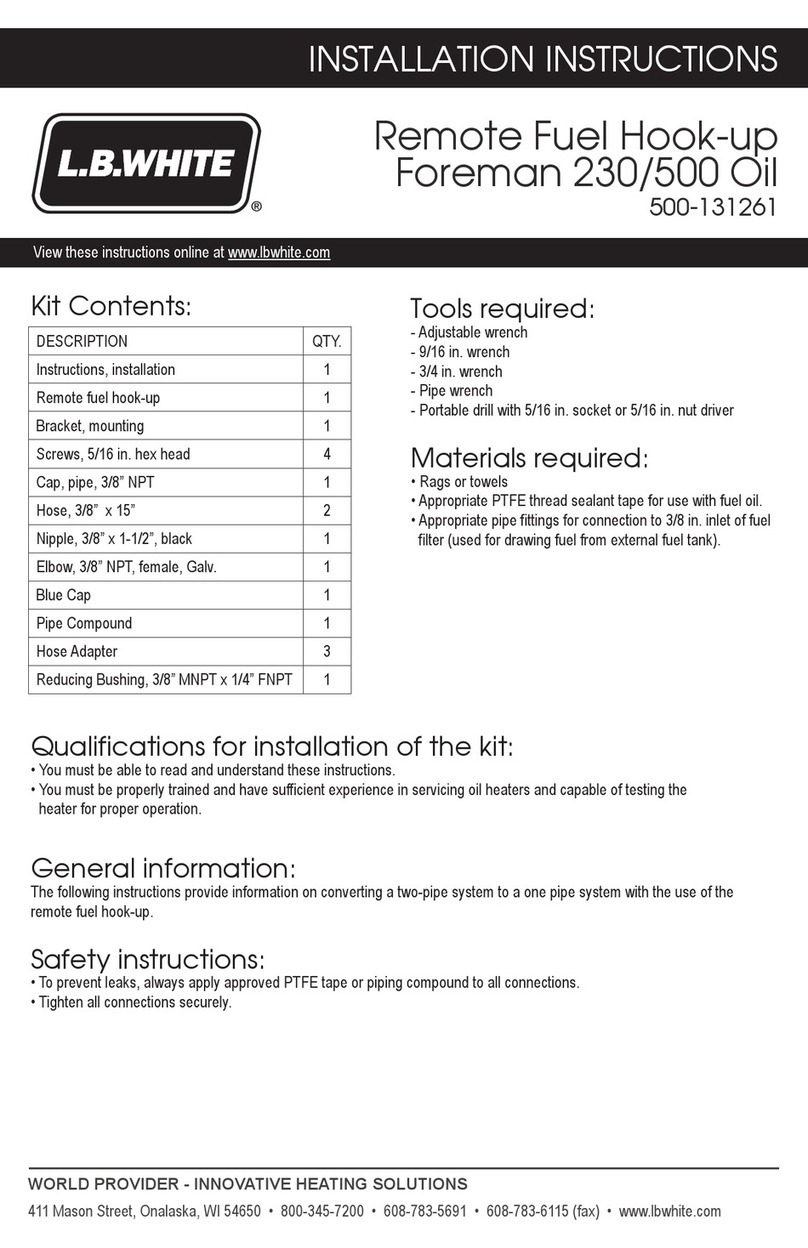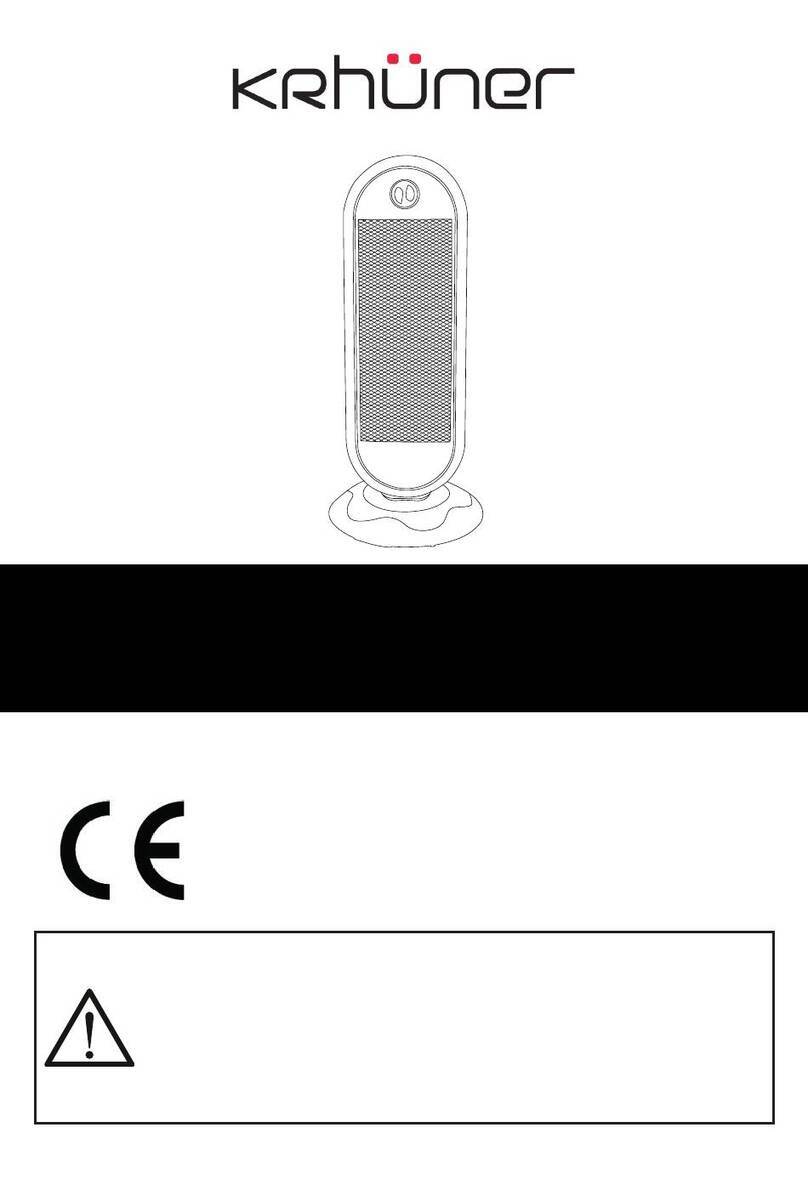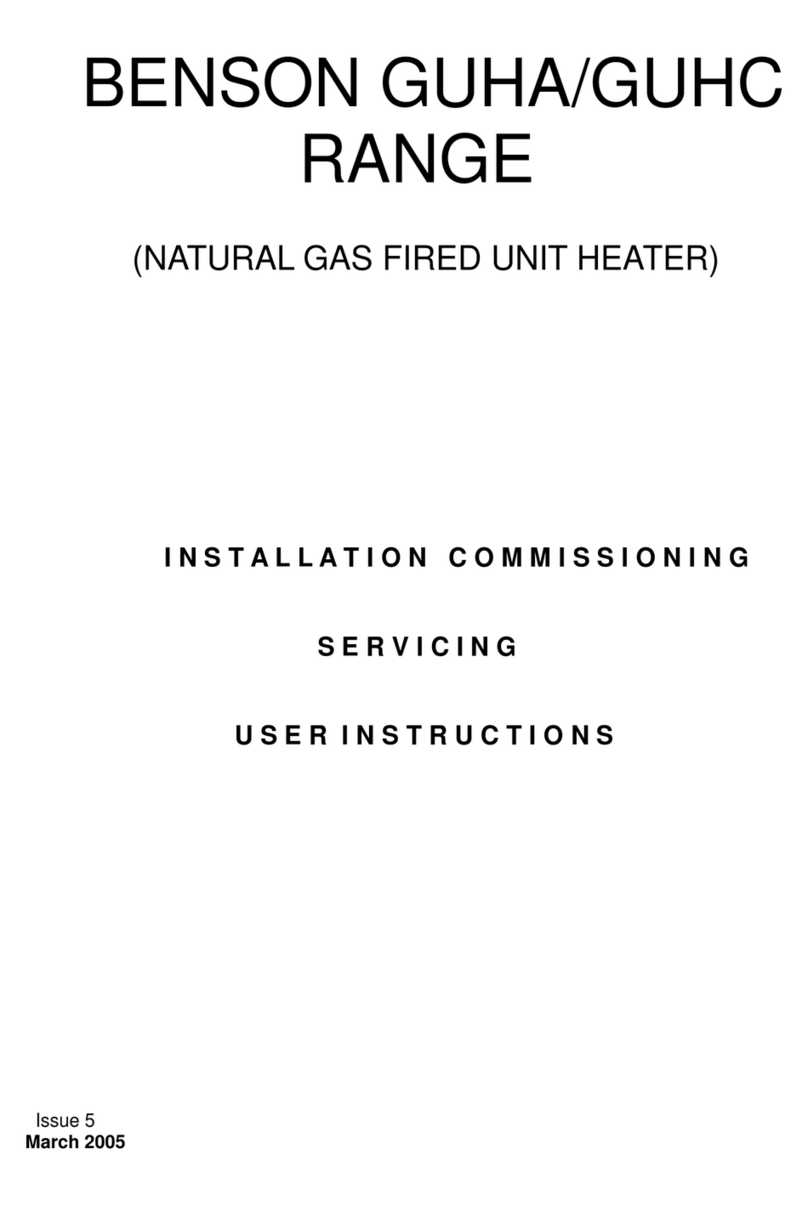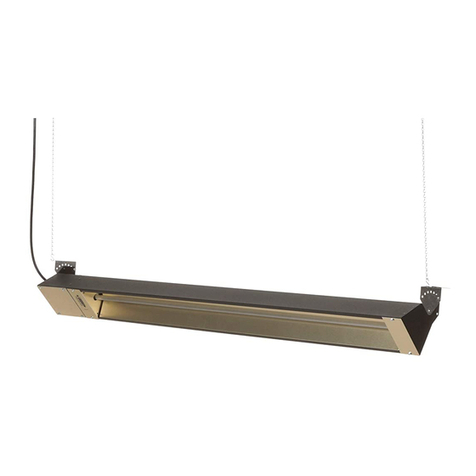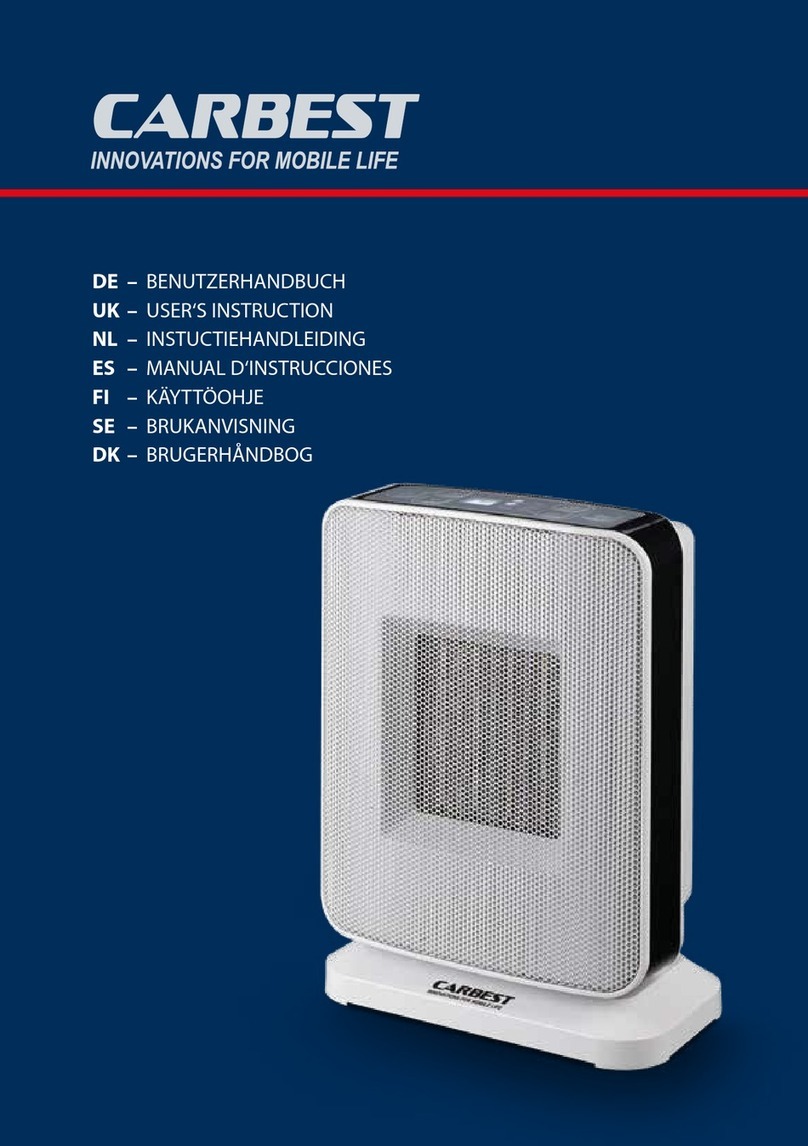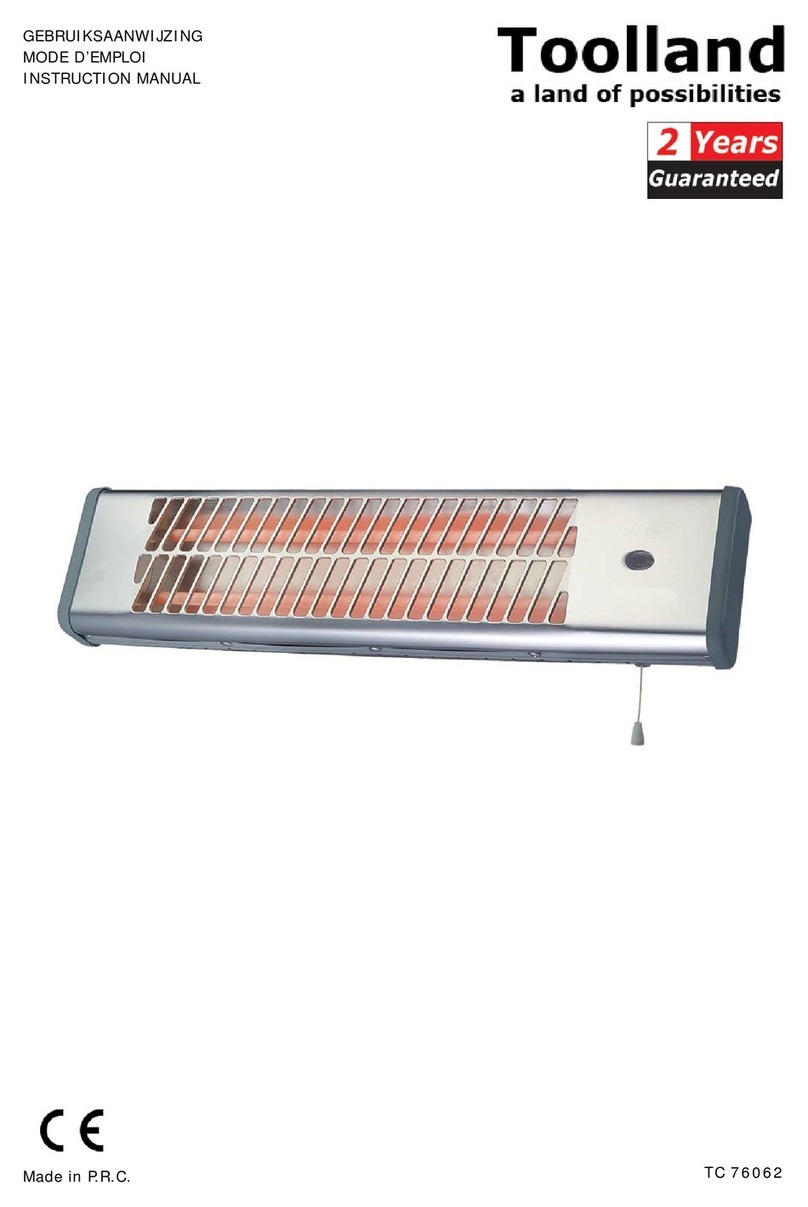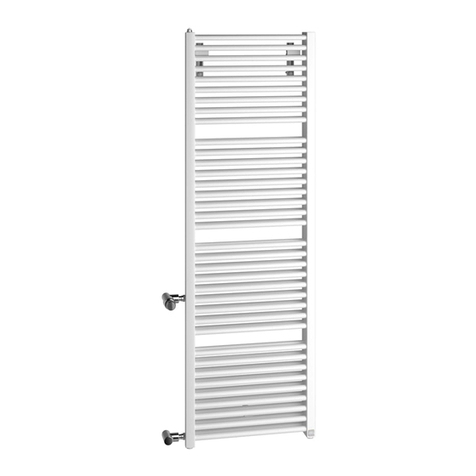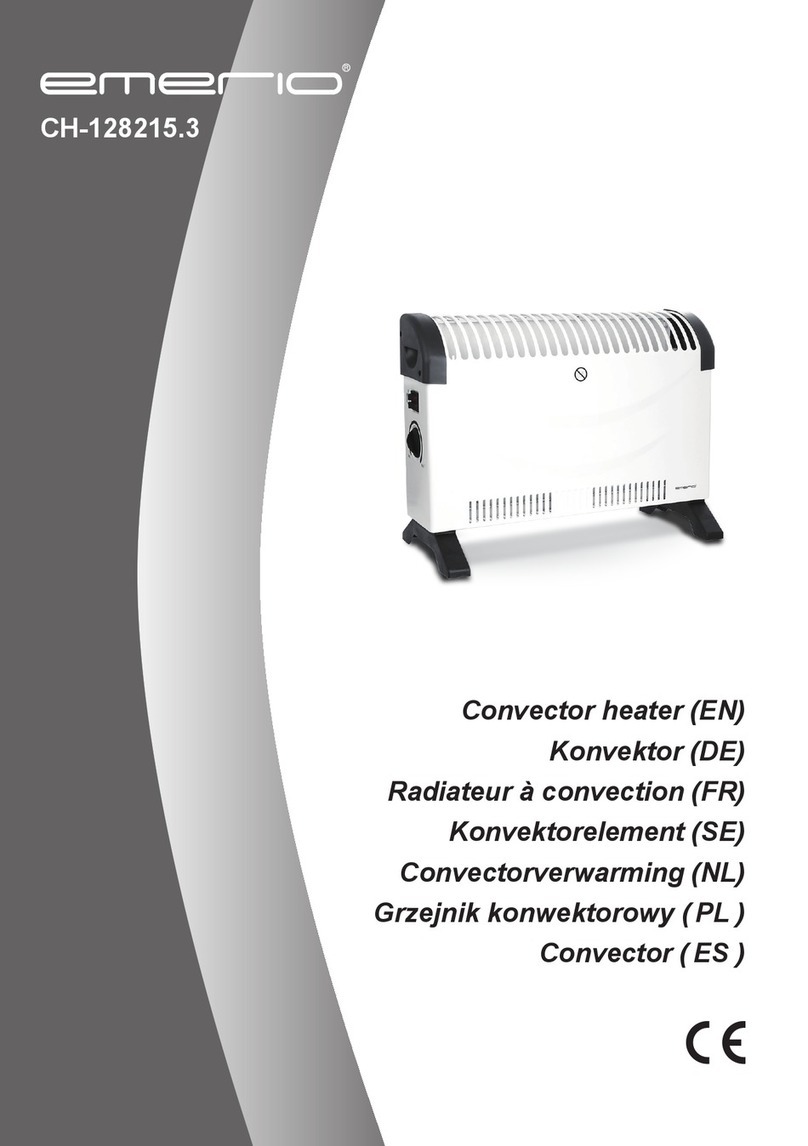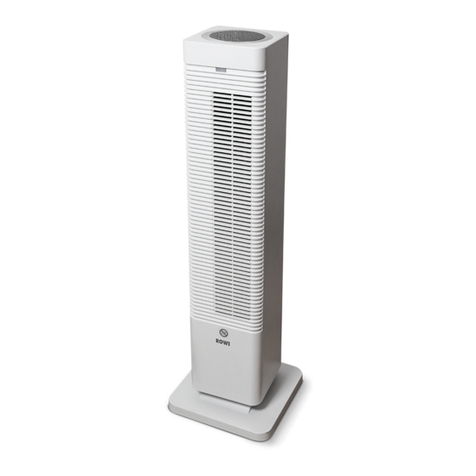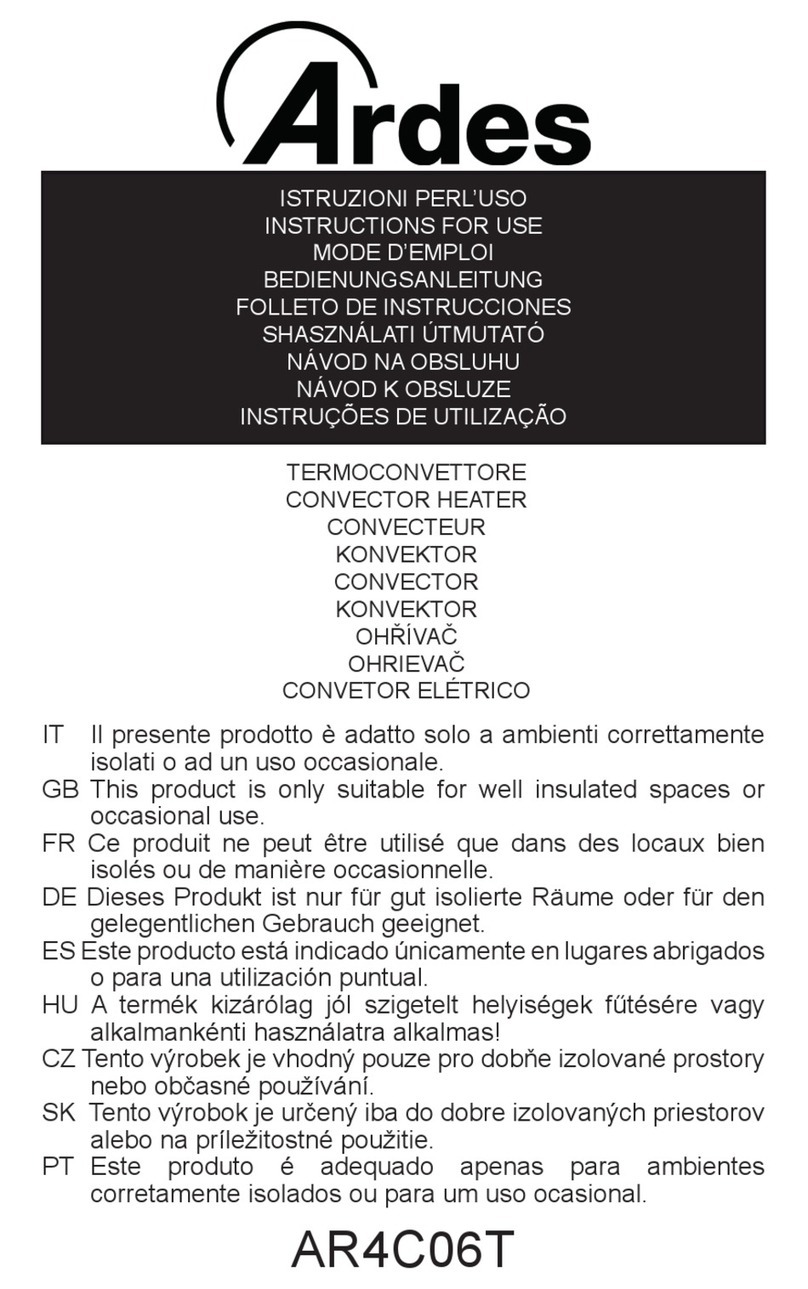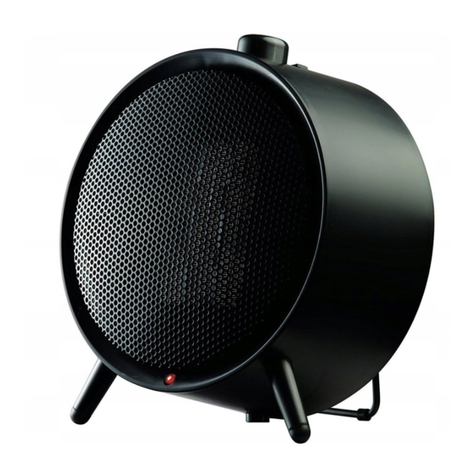Robur TS 2000 User manual

individual natural gas/LPG natural draught gas-red
convectors
TS 2000
Installation, use and maintenance manual

Revision: A
Code: D-LBR094EN
This Installation, use and maintenance manual has been drawn up and printed by Robur S.p.A.; whole or partial
reproduction of this Installation, use and maintenance manual is prohibited.
The original is led at Robur S.p.A.
Any use of this Installation, use and maintenance manual other than for personal consultation must be previously
authorised by Robur S.p.A.
The rights of those who have legitimately led the registered trademarks contained within this publication are not
aected.
With the aim of continuously improving the quality of its products, Robur S.p.A. reserves the right to modify the
data and contents of this Installation, use and maintenance manual without prior notice.

Installation, use and maintenance manual – TS 2000 3
I Introduction..........................................................................
p.4
I.1 Recipients................................................................
p.4
II Symbols and denitions.........................................
p.4
II.1 Key to symbols ......................................................
p.4
II.2 Terms and denitions .........................................
p.4
III Warnings...................................................................................
p.4
III.1 General and safety warnings............................
p.4
III.2 Compliance.............................................................
p.5
III.3 Exclusions of liability and warranty ...............
p.5
1 Features and technical data................................
p.7
1.1 Features....................................................................
p.7
1.2 Dimensions.............................................................
p.7
1.3 Technical data........................................................
p.8
2 Transport and positioning....................................
p.8
2.1 Warnings..................................................................
p.8
2.2 Handling..................................................................
p.8
2.3 Appliance positioning ........................................
p.8
2.4 Minimum clearance distances.........................
p.9
3 Heating engineer.............................................................
p.9
3.1 Warnings..................................................................
p.9
3.2 Supplied material.................................................
p.9
3.3 Fuel gas supply......................................................
p.9
3.4 Combustion products exhaust......................
p.10
3.5 Installation procedure ......................................
p.10
4 First start-up.......................................................................
p.12
4.1 Preliminary checks.............................................
p.12
4.2 Checking burner gas pressure.......................
p.12
4.3 Gas changeover ..................................................
p.14
5 Normal operation.........................................................
p.15
5.1 Warnings................................................................
p.15
5.2 Control knob........................................................
p.15
5.3 Switch on and o................................................
p.15
6 Maintenance.......................................................................
p.16
6.1 Warnings................................................................
p.16
6.2 Cleaning and maintenance.............................
p.16
6.3 Any malfunctions of operation .....................
p.16
7 Appendices...........................................................................
p.17
7.1 ErP technical sheet.............................................
p.17

Introduction
4
I
I INTRODUCTION
Installation, use and maintenance manual
This Manual is an integral part of the TS 2000 appli-
ance and must be handed to the end user together
with the appliance.
I.1 RECIPIENTS
This Manual is intended for:
▶
End user, for appropriate and safe use of the appliance.
▶
Qualied installer, for correct appliance installation.
▶
Planner, for specic information on the appliance.
II SYMBOLS AND DEFINITIONS
II.1 KEY TO SYMBOLS
DANGER
WARNING
NOTE
PROCEDURE
REFERENCE (to other document)
II.2 TERMS AND DEFINITIONS
Appliance/Unit = equivalent terms, both used to refer to
the independent direct exchange gas-red convector.
TAC = Technical Assistance Centre authorised by Robur.
First start-up = appliance commissioning operation
which may only and exclusively be carried out by a TAC.
III WARNINGS
III.1 GENERAL AND SAFETY WARNINGS
Installer's qualications
Installation must exclusively be performed by a
qualied rm and by skilled personnel, with spe-
cic knowledge on heating, electrical systems and
gas appliances, in compliance with the laws in
force in the Country of installation.
Declaration of conformity
Upon completing installation, the installing rm
shall issue to the owner/client the appliance's
workmanlike conformity declaration, according to
national/local regulations in force and the manu-
facturer's instructions/provisions.
Misuse
The appliance must only be used for the purpos-
es for which it has been designed. Any other use is
deemed hazardous. Incorrect use may aect oper-
ation, duration and safety of the appliance. Adhere
to the manufacturer's instructions.
Use of the appliance by children
The appliance can be used by children over 8 years
old, and by people with reduced physical, senso-
ry or mental capabilities, or lack of experience or
knowledge, only if they are under surveillance or
after they have received instructions regarding
safe use of the appliance and understanding the
dangers inherent in it. Children should not play
with the appliance.
Hazardous situations
Do not start the appliance in hazardous conditions,
such as: gas smell, problems with the electrical/gas
system, parts of the appliance under water or dam-
aged, malfunctioning, disabling or bypassing con-
trol and safety devices.
In case of danger, request intervention by qualied
personnel.
In case of danger, switch o the electrical power
and gas supplies only if this can be done in total
safety.
Do not entrust children, persons with physical,
sensory or mental disabilities or persons with poor
knowledge and experience with use of the appli-
ance.
Gas component tightness
Before performing any operation on gas ducting
components, close the gas valve.
Upon completing any procedure, perform the

Warnings
Installation, use and maintenance manual – TS 2000 5
III
tightness test according to regulations in force.
Gas smell
If you smell gas:
Do not use electrical devices such as telephones,
multimeters or other equipment that may cause
sparks next to the appliance.
Shut o the gas supply by turning the valve o.
Open immediately doors and windows to create a
cross-current of air to ventilate the room.
Switch o the power supply via the external dis-
connect switch in the power supply electrical pan-
el.
Use a telephone away from the appliance to ask for
intervention from qualied personnel.
Poisoning
Ensure the ue gas ducts are tight and compliant
with the regulations in force.
Upon completing any procedure, ensure the tight-
ness of the components.
Burn hazard
The appliance contains very hot parts.
Do not open the appliance and do not touch inter-
nal components before the appliance has cooled
down.
Do not touch the ue gas exhaust before it has
cooled down.
Air ow
Do not obstruct the air intake or the warm air
outlet.
Distance from combustible or ammable mate-
rials
Do not deposit ammable materials (paper, dilu-
ents, paints, etc.) near the appliance.
Comply with current regulations.
Aggressive substances in the air
The air of the installation site must be free from ag-
gressive substances.
In the event of failure
Operations on internal components and repairs
may exclusively be carried out by a TAC, using only
original spare parts.
In the event of failure of the appliance and/or
breakage of any component, do not attempt to
repair and/or restore and immediately contact the
TAC.
Routine maintenance
Proper maintenance assures the eciency and
good operation of the appliance over time.
Maintenance must be performed according to the
manufacturer's instructions (see Chapter 6
p. 16
)
and in compliance with current regulations.
Appliance maintenance and repairs may only be
entrusted to rms legally authorised to work on
gas appliances and systems.
Enter into a maintenance contract with an author-
ised specialised rm for routine maintenance and
for servicing in case of need.
Use only original parts.
Keep the Manual
This Installation, use and maintenance manual
must always accompany the appliance and must
be handed to the new owner or installer in the
event of sale or removal.
III.2 COMPLIANCE
EU directives and standards
The TS 2000 series gas-red convectors are certied in
accordance with European regulation GAR 426/2016/
EU and meet the essential requirements of the following
Directives:
▶
2016/426/EU "Gas Appliances Regulation" as amend-
ed and added.
Furthermore, they comply with the requirements of the
following standards:
▶
EN 613 Independent gas-red convection heaters
Other applicable provisions and standards
The design, installation, operation and maintenance of
the systems shall be carried out in compliance with cur-
rent applicable regulations, depending on the Country
and location, and in accordance with the manufacturer's
instructions. In particular, regulations regarding the fol-
lowing shall be complied with:
▶
Gas systems and equipment.
▶
Heating systems.
▶
Environmental protection and combustion products
exhaust.
▶
Fire safety and prevention.
▶
Any other applicable law, standard and regulation.
III.3 EXCLUSIONS OF LIABILITY AND
WARRANTY
Any contractual or extra-contractual liability of the
manufacturer for any damage caused by incorrect
installation and/or improper use and/or failure to
comply with regulations and with the manufactur-
er's directions/instructions shall be disclaimed.
In particular, the warranty on the appliance may be
rendered void by the following conditions:

Warnings
6
III
Incorrect installation.
Misuse.
Failure to comply with the manufacturer's indica-
tions on installation, use and maintenance.
Alteration or modication of the product or any
part thereof.
Extreme operational conditions or however out-
side of the operational ranges set forth by the man-
ufacturer.
Damages caused by external agents such as salts,
chlorine, sulphur or other chemical substances
present in the air of the installation site.
Abnormal actions transmitted to the appliance by
the system or installation (mechanical stresses,
pressure, vibrations, thermal expansion, electrical
surges...).
Accidental damages or due to force majeure.

Features and technical data
Installation, use and maintenance manual – TS 2000 7
1
1 FEATURES AND TECHNICAL DATA
1.1 FEATURES
1.1.1 Operation
The TS 2000 gas-red convector is an independent heat-
ing appliance with sealed combustion chamber and natu-
ral draught with balanced ow.
It has been designed to be installed inside the room to be
heated.
It can operate either with natural gas (G20) and LPG (G30/
G31) (gas-red convector belonging to category II2H3+ ac-
cording to EN 613).
The combustion air intake and the ue gas outlet take
place outside the installation room by means of two coax-
ial pipes. Therefore the appliance must be positioned on
an external perimeter wall.
The dual function of air intake and ue gas exhaust per-
formed by the coaxial duct does not allow for connection
to traditional ues.
The operation principle of the TS 2000 gas-red convec-
tor is based on a convective motion of room air that pass-
es through the gas-red convector from bottom to top,
is heated and diused into the room through the upper
grille.
For this reason it is important not to obstruct
the air outlet by placingclothing or any other
objects over the outlet grille; always keep cur-
tains, chairs or any other furniture at least 30
cm away from the heater.
The operation of the appliance, which is very simple in
itself, is made completely automatic by the thermostatic
regulation: in fact, the user only requires the preliminary
ignition operation and the choice of the desired tempera-
ture (set on the thermostatic control knob).
The sealed combustion chamber is the best guarantee of
safety for the environment in which the gas-red convec-
tor is installed: there is no possibility of the products of
combustion leak, nor is the oxygen necessary for combus-
tion taken from the environment. The appliance, once in-
stalled in accordance with the installation standards, does
not require any ventilation openings in the room.
A ame detection device using a thermocouple interrupts
the gas supply in the event of an accidental shutdown.
1.1.2 Mechanical components
▶
Sealed combustion chamber.
▶
High-eciency aluminium alloy heat exchanger.
▶
Ø 100/60 mm coaxial combustion air intake and ue
gas exhaust pipes.
▶
External ue gas terminal in aluminium alloy.
▶
Casing in epoxy powder-coated sheet metal.
▶
Support bracket for wall mounting.
1.1.3 Control and safety devices
▶
Gas valve providing the following functions:
burner ignition
ame monitoring
heat exchanger temperature probe control
▶
Heat exchanger temperature control probe
▶
Piezoelectric ignition button
▶
Thermostatic control knob
1.2 DIMENSIONS
Figure1.1Dimensions
170
100
480
190 290
100
100
< 350
> 50
100
100
577

Transport and positioning
8
2
1.3 TECHNICAL DATA
Table1.1Technical data
TS 2000
Heating mode
Heat input nominal (1013 mbar - 15 °C) (1) kW 2,0
Heat output nominal kW 1,7
Eciency nominal heat input % 85,8
Installation data
Gas consumption
G20 natural gas (nominal) m³/h 0,20
G30 (nominal) kg/h 0,15
G31 (nominal) kg/h 0,15
Gas connection thread “ 3/8
Flue gas exhaust
type of installation - C11
diameter (Ø) mm 60/100 (2)
residual head Pa 0 (3)
Dimensions
width mm 480
height mm 577
depth mm 170
Weight in operation kg 17
(1) Relative to NCV (net caloric value).
(2) Coaxial pipe: ue gas exhaust Ø 60 mm, air intake Ø 100 mm.
(3) It is not possible to use coaxial pipes other than the one supplied. The minimum wall thickness must be 150 mm, the maximum 500 mm.
2 TRANSPORT AND POSITIONING
2.1 WARNINGS
Damage from transport or installation
The manufacturer shall not be liable for any dam-
age during appliance transport and installation.
On-site inspection
Upon arrival at the site, ensure there is no transport
damage on packing.
After removing the packing materials, ensure the
appliance is intact and complete.
Packing
Only remove the packing after placing the appli-
ance on site.
Do not leave parts of the packing within the reach
of children (plastic, polystyrene, nails...) since they
are potentially dangerous.
Weight
The lifting equipment must be suitable for the load.
Lift up the appliance and secure it to its support
bracket.
2.2 HANDLING
2.2.1 Handling and lifting
▶
Always handle the appliance in its packing, as deliv-
ered by the factory.
▶
Comply with safety regulations at the installation site.
2.3 APPLIANCE POSITIONING
The appliance must be installed in the room to be heated.
2.3.1 Where to install the appliance
▶
The gas-red convector must be installed on an exter-
nal perimeter wall, respecting the distances indicated
in Figure 1.1
p.7
.
▶
Avoid placement on walls or combustible materials
without a suitable heat shield.
▶
Do not install the gas-red convector over electrical
boxes/switches or distribution cabinets that require
periodic inspection.
Installation must not be made on walls with poor
strength that do not guarantee adequate resist-
ance to the stresses produced by the appliance.
The manufacturer assumes no responsibility if the
appliance is installed on surfaces or walls that are
not suitable to support its weight.
The appliance's ue gas exhaust must not be im-
mediately close to openings or air intakes of build-
ings, and must comply with safety and environ-
mental regulations.
The ue gas exhaust terminal is accident-pre-
venting and requires no protection.

Transport and positioning
Installation, use and maintenance manual – TS 2000 9
2
2.4 MINIMUM CLEARANCE DISTANCES
2.4.1 Distances from combustible or ammable
materials
▶
Keep the appliance away from combustible or am-
mable materials or components, in compliance with
applicable regulations.
2.4.2 Clearances around the appliance
The minimum clearance distances are required for
safety, operation and maintenance.
▶
The minimum recommended distance from the gas-
red convector to the oor is 5 cm (Figure 1.1
p. 7
)
and possibly not more than 35 cm, as higher heights
would result in uneven heat distribution in the heated
room.
▶
Keep a minimum clearance of 10 cm from the sides of
the gas-red convector to any obstacles to allow for
removal and retting of the casing.
▶
If a shelf is to be installed above the gas-red convec-
tor, leave a minimum clearance of 10 cm. No cover of
any type may be installed over the appliance.
3 HEATING ENGINEER
3.1 WARNINGS
3.1.1 General warnings
Read the warnings in Chapter III.1
p. 4
, pro-
viding important information on regulations and
on safety.
Compliance with installation standards
Installation must comply with applicable regula-
tions in force, based on the installation Country
and site, in matters of safety, design, implementa-
tion and maintenance of:
heating systems
gas systems
ue gas exhaust
Installation must also comply with the manufactur-
er's provisions.
3.2 SUPPLIED MATERIAL
▶
Installation jig in cardboard.
▶
Wall support bracket.
▶
Air duct Ø 100 mm, length 500 mm.
▶
Flue gas duct Ø 60 mm, length 500 mm.
▶
External ue gas terminal in aluminium alloy.
▶
Round gasket for combustion air.
▶
Screws and wall plugs.
▶
Documentation.
3.3 FUEL GAS SUPPLY
3.3.1 Gas connection
▶
3/8"
on the right, at the bottom.
▶
Install an anti-vibration connection between the ap-
pliance and the gas piping.
The connection to the gas mains must be made
using a rigid copper or steel pipe and ttings; alter-
natively, a exible stainless steel pipe conforming
to the regulations in force may also be used.
The connection to the gas pipe must be properly
sealed to ensure tightness using a sealant that
complies with EN 751-1 and EN 751-2. The connec-
tion must be made in such a way that no strain is
produced in the pipe or gas-red convector com-
ponents.
3.3.2 Mandatory shut-o valve
▶
Provide a gas shut-o valve (manual) on the gas supply
line, next to the appliance, to isolate it when required.
▶
Provide a three-piece pipe union.
▶
Perform connection in compliance with applicable
regulations.
3.3.3 Gas pipes sizing
The gas pipes must not cause excessive pressure drops
and, consequently, insucient gas pressure for the
appliance.
3.3.4 Supply gas pressure
This appliance is equipped for a maximum gas
supply pressure of 50 mbar.
The appliance's gas supply pressure, both static and dy-
namic, must comply with Table 3.1
p.10
, with tolerance
± 15%.
Non compliant gas pressure (Table 3.1
p. 10
)
may damage the appliance and be hazardous.

Transport and positioning
10
2
Table3.1Network gas pressure
Gas supply pressure [mbar]
Product category Countries of destination G20 G30 G31 G30 G31
II2H3B/P CH, CZ, DK, EE, FI, GR, IT, LT, NO, RO, SE, SI, SK 20 30
AT 20 50
II2H3P CH, CZ, ES, GR, HR, IE, IT, LT, PT, SI, SK 20 37
II2H3+ CH, CY, CZ, ES, GB, GR, IE, IT, LT, PT, SI, SK, TR 20 28-30 37
The appliance gas supply pressure, both static and dynamic, must comply with the values in theTable, with a tolerance of ± 15%.
3.3.5 Vertical pipes and condensate
▶
Vertical gas pipes must be tted with siphon and dis-
charge of the condensate that may form inside the
pipe.
▶
If needed, insulate the piping.
3.3.6 LPG pressure reducers
With LPG the following must be installed:
▶
A rst stage pressure reducer, close to the liquid gas
tank.
▶
A second stage pressure reducer, close to the appli-
ance.
Pressure reducers must always be installed outside
the building.
3.4 COMBUSTION PRODUCTS EXHAUST
Compliance with standards
The appliance is approved for connection to a
combustion products exhaust duct for the types
shown in Table 1.1
p.8
.
3.4.1 Flue gas exhaust and combustion air
intake connection
▶
Ø 60/100 mm on the rear (Figure 1.1
p.8
)
3.4.2 Installation types
The ue gas exhaust/air intake of the TS 2000 gas-red
convectors must be carried out, using the supplied coax-
ial pipes, on the installation wall (maximum pipe length
50 cm).
Warnings
The installation of coaxial pipes with a vertical
downward outlet is prohibited (leads to recircula-
tion of ue gas with lock-out of the appliance).
It is forbidden to install coaxial pipes with a vertical
outlet upwards (due to rain, water, objects inltra-
tion, with consequent lock-out of the appliance).
3.5 INSTALLATION PROCEDURE
In accordance with the installation project, prepare the
gas supply line and make the holes for the ue and com-
bustion air intake pipes.
3.5.1 Install the gas-red convector on the wall
1. Check the packaging for visible signs of damage, oth-
erwise, notify the carrier immediately.
2. Remove the gas-red convector from its packaging
by rst removing the air intake and ue gas exhaust
pipes. Do not damage or discard the cardboard jig
with the drilling template required for installing the
gas-red convector.
3. Fix the jig to the wall where the gas-red convector is
to be installed, making sure it is perpendicular to the
oor.
4. Mark on the wall the holes for the air intake and ue
gas exhaust duct and for the two wall plugs that will
hold the support bracket.
5. Drill the hole (Ø 100 mm) to house the coaxial pipe
and holes to x the support bracket (drill 6 mm holes
to insert the provided wall plugs). The Ø 100 mm hole
for the duct can be made with a suitable core drill or
by means of a succession of smaller holes made with a
simple drill on the perimeter to be removed.
If the appliance is to be installed on a wall cov-
ered with ammable material, such as wallpaper,
matchboarding, etc., part of this must be removed
to a Ø 130 mm around the ue outlet hole to reach
the bare wall. If it is not possible to remove only
the ammable layer (e.g. all-wood walls) it will be
necessary to drill a hole 30 mm deep around the
pipe (see Figure 3.1
p.10
).
Figure3.1Ø 130 hole drilling
130 mm
30 mm
6. Use the supplied plugs to x the support bracket to
the wall, making sure that the holes at the ends of the
bracket are at the bottom (see Figure 3.2
p. 11
). It
is recommended, even at this stage, to check that the
bracket is parallel to the oor.

Transport and positioning
Installation, use and maintenance manual – TS 2000 11
2
7. Adjust the length of the pipes (intake and exhaust)
to the eective wall thickness, cutting the tract in ex-
cess: for the exact length determination, see Figure
3.3
p.11
.
Figure3.2Correct positioning of the support bracket
A Holes for securing the support bracket to the wall
A
Figure3.3Length of intake and exhaust pipes
A Wall thickness
B Flue gas exhaust pipe
C Air pipe
A + 9 cm
A + 1 cm
A
60
100
B
C
8. Remove the casing from the heating body by un-
screwing the screws at the top and bottom (see gure
3.4
p.11
).
9. Insert the ue gas exhaust pipe B in the combustion
chamber. Fit the air pipe C and then x it to the appli-
ance with the screws provided, inserting the sealing
gasket D (see Figure 3.5
p.11
).
10.Place the gas-red convector on the wall by introduc-
ing the intake/exhaust pipe into the hole previously
made and hooking the gas-red convector to the sup-
port bracket by means of the specic holes G on the
back of the gas-red convector (see Figure 3.5
p.11
).
11.Secure the heating body to the wall by tightening the
two locking screws on the support bracket. Further
minor adjustments to the position can be made at this
stage.
12.Connect the gas network as described in Paragraph
3.3
p.9
.
13.Fit the casing and tighten the locking screws (see
Figure 3.4
p.11
).
Figure3.4Remove the casing by unscrewing the screws
Figure3.5Installation of coaxial pipes and terminal
A Support bracket
B Flue gas exhaust pipe
C Air pipe
D Gasket
E External windproof terminal
F Holes for xing the terminal
G Support bracket xing holes
A
B
C
D
E
F
F
F
G
G

First start-up
12
5
3.5.2 Install the windproof terminal
1. Apply the aluminium windproof terminal to the exter-
nal wall so that it engages with the end of the coaxial
pipe and mark the position of the three holes F for the
expansion plugs (see Figure 3.5
p.11
).
2. Remove the terminal and drill the xing holes (Ø 6 mm
for the supplied wall plugs).
3. Reassemble the terminal and secure it with the screws
using the relevant plugs.
4 FIRST START-UP
First start-up entails checking/setting up the com-
bustion parameters and may exclusively be carried
out by a Robur TAC. NEITHER the user NOR the in-
stallation technician is authorised to perform such
operations, under penalty of voiding the warranty.
The installer is obliged to carry out preliminary
checks described in Paragraph 4.1
p.12
.
4.1 PRELIMINARY CHECKS
Paragraph dedicated to the installer.
4.1.1 Preliminary checks for rst start-up
Upon completing installation, before contacting the TAC
the installer must check:
▶
Gas system suitable for the required capacities and
equipped with all safety and control devices required
by the regulations in force.
▶
Absence of leaks in the gas system.
▶
Type of gas for which the appliance is designed (natu-
ral gas, LPG or other gas).
▶
Supply gas pressure complying with the values of
Table 3.1
p.10
, with max tolerance ±15%.
▶
Correct operation of the ue exhaust duct.
▶
Combustion air intake and ue gas exhaust correctly
carried out according to the regulations in force.
▶
Appliance correctly installed, according to the manu-
facturer's provisions.
▶
System installed in a workmanlike manner, according
to national and local regulations.
4.1.2 Abnormal or hazardous installation
situations
Should any abnormal or hazardous installation situations
be found, the TAC shall not perform rst start-up and the
appliance shall not be commissioned.
These situations may be:
▶
Failed compliance with minimum clearances.
▶
Insucient distance from combustible materials.
▶
Conditions that do not warrant access and mainte-
nance in safety.
▶
Appliance defects or faults caused during transport or
installation.
▶
Gas smell.
▶
Non-compliant mains gas pressure.
▶
Non-compliant ue gas exhaust.
▶
All situations that may involve operation abnormali-
ties or are potentially hazardous.
4.1.3 Non-compliant system and corrective
actions
Should theTAC nd any non conformities, the user/install-
er is bound to perform any corrective procedures required
by the TAC.
After performing the remedial actions (the installer's re-
sponsibility), if the TAC deems that safety and conformity
conditions are in place, rst start-up may be eected.
4.2 CHECKING BURNER GAS PRESSURE
Paragraph reserved exclusively toTACs.
The gas supply circuit is equipped with a gas valve
with pressure regulator (Figure 4.1
p. 13
) to
control the gas ow. All models are factory-set to
operate with natural gas and can be converted to
LPG (see Paragraph 4.3.1
p. 14
). Each gas-red
convector is calibrated during factory testing for
operation with natural gas. After installation, check
that the gas pressure at the burner complies with
indications in Paragraph 4.2
p.12
.
All adjustments must be made with the appliance
switched on and after removing the casing.
After completion of the gas pressure check at
the burner, the valve adjustment screws must be
sealed.

First start-up
Installation, use and maintenance manual – TS 2000 13
5
Figure4.1Gas valve
A Control knob
B Temperature-sensitive bulb
C Gas regulator at maximum heat input
D Gas regulator at minimum heat input
E Pilot ame regulator
F Outlet pressure intake
G Inlet pressure intake
A
B
C
D
E
F
G
4.2.1 Natural gas supply
4.2.1.1 Pressure adjustment at maximum heat input
Pressure adjustment to the maximum heat input
should be carried out with the appliance operating
at a room temperature of no more than 20° C.
If the installation is carried out at room tempera-
tures above 20 °C, immerse the sensor bulb in cold
water after having removed it from its supports.
Figure 4.1
p.13
.
1. Connect a pressure gauge to the outlet pressure sock-
et F on the gas valve.
2. Switch on the appliance (Paragraph 5.3.1
p.15
).
3. Set control knob A to maximum value (position 7).
4. Adjust the gas pressure at the maximum heat input to
the required value (Table 4.1
p.13
) by means of the
pressure regulator D. By turning clockwise the pres-
sure increases, counterclockwise it decreases.
5. Check the pressure value after removing the screw-
driver from the adjustment screw.
Table4.1Burner gas pressure
TS 2000
Installation data
Burner gas
pressure
Nominal heat input
G20 mbar 16,2
G30 mbar 29,0
G31 mbar 37,0
Minimal heat input
G20 mbar 6,2
G30 mbar 15,0
G31 mbar 18,0
4.2.1.2 Pressure adjustment at minimum heat input
Figure 4.1
p.13
.
1. With the pressure gauge in place and the appliance
running, slowly turn knob A to the position as close
as possible to the position where the appliance is
switched o.
2. Adjust the gas pressure at the minimum heat input to
the required value (Table 4.1
p.13
) by means of the
pressure regulator D. By turning counterclockwise the
pressure increases, clockwise it decreases.
3. Check the pressure value after removing the screw-
driver from the adjustment screw.
4.2.2 LPG supply
For LPG supply, the gas-red convector must be convert-
ed from natural gas to LPG by using the supplied gas
change kit and following the instructions in Paragraph
4.3.1
p.14
.
When operating with LPG gas, the maximum operating
pressure depends only on the network pressure, which
must be as indicated in Table 3.1
p.10
.
The reduction of the pressure in the network is
possible following the instructions in Paragraph
3.3.6
p.10
.
To adjust the gas-red convector for operation with LPG,
proceed as described below.
4.2.2.1 Pressure adjustment at maximum heat input
Pressure adjustment to the maximum heat input
should be carried out with the appliance operating
at a room temperature of no more than 20° C.
If the installation is carried out at room tempera-
tures above 20 °C, immerse the sensor bulb in cold
water after having removed it from its supports.
Figure 4.1
p.13
.
1. Connect a pressure gauge to the outlet pressure sock-
et F on the gas valve.
2. Switch on the appliance (Paragraph 5.3.1
p.15
).
3. Set control knob A to maximum value (position 7).
4. Adjust the maximum gas pressure at the burner by ex-
cluding the pressure regulator C, screwing the screw
in completely.
5. Check the pressure value after removing the screw-
driver from the adjustment screw.
4.2.2.2 Pressure adjustment at minimum heat input
Figure 4.1
p.13
.
1. With the pressure gauge in place and the appliance
running, slowly turn knob A to the position as close
as possible to the position where the appliance is
switched o.
2. Adjust the gas pressure at the minimum heat input to
the required value (Table 4.1
p.13
) by means of the

First start-up
14
5
pressure regulator D. By turning counterclockwise the
pressure increases, clockwise it decreases.
3. Check the pressure value after removing the screw-
driver from the adjustment screw.
4.3 GAS CHANGEOVER
Paragraph reserved exclusively toTACs.
After the gas changeover, check the combustion
parameters as described in Paragraph 4.2
p.12
.
Check that the gas supply line is suitable for the
new fuel type used to supply the unit.
4.3.1 Conversion from natural gas to LPG
Figure 4.2
p.14
.
1. Cut o gas supply.
2. Remove the casing from the frame.
3. Disconnect gas pipe A.
4. Unscrew the nozzle holder B.
5. Unscrew the nozzle and replace it (Table 4.2
p.14
).
6. Screw the nozzle support and nozzle assembly back
on to the burner.
7. Connect gas pipe A.
8. Check the gas pressure at the burner as described in
Paragraph 4.2.2
p.13
.
9. Remove the "NATURAL GAS" adhesive label and re-
place it with the "LPG" adhesive label.
10.Replace the casing.
Figure4.2Gas changeover
A Gas pipe
B Nozzle holder.
C Nozzle
A
B
C
Table4.2Gaz nozzles
TS 2000
Installation data
Nozzle
Diameter (Ø)
G20 mm 3.00/1,20 (1)
G30 mm 3.00/0,70 (1)
G31 mm 3.00/0,70 (1)
Code
G20 - 268
G30 - 269
G31 - 269
(1) Main burner nozzle. Pilot burner nozzle: 0,30 mm.
4.3.2 Conversion from LPG to natural gas
Figure 4.2
p.14
.
1. Cut o gas supply.
2. Remove the casing from the frame.
3. Disconnect gas pipe A.
4. Unscrew the nozzle holder B.
5. Unscrew the nozzle and replace it (Table 4.2
p.14
).
6. Screw the nozzle support and nozzle assembly back
on to the burner.
7. Connect gas pipe A.
8. Check the gas pressure at the burner as described in
Paragraph 4.2.1
p.13
.
9. Remove the "LPG" adhesive label and replace it with
the "NATURAL GAS" adhesive label.
10.Replace the casing.

Normal operation
Installation, use and maintenance manual – TS 2000 15
6
5 NORMAL OPERATION
This section is for the end user.
The operation of the TS 2000 gas-red convectors is con-
trolled by the control knob on the appliance.
5.1 WARNINGS
General warnings
Prior to using the appliance carefully read the
warnings in Chapter III.1
p. 4
, providing impor-
tant information on regulations and on safety.
First startup by TAC
First start-up may exclusively be carried out by a
Robur TAC (Chapter 6
p.16
).
Do not obstruct the lower grille or the upper air
outlet grille.
During operation of the appliance, pay atten-
tion to the upper grille, which is hot.
Do not obstruct the air intake and ue gas ex-
haust ducts located outside the room.
5.2 CONTROL KNOB
Figure5.1Control knob
A Piezoelectric ignition button
B Control knob
1 Minimum temperature
7 Maximum temperature
Position for ignition (pilot ame)
Position for switching o
A
B
5.3 SWITCH ON AND OFF
5.3.1 Switching on
Figure 5.1
p.15
.
1. Open the gas valve.
2. Turn the control knob to position .
3. Press the knob fully.
4. While keeping the knob pressed down, press button A
on the piezo igniter of the pilot ame.
5. Wait a few seconds then release the knob. The pilot
ame will remain lit.
The rst ignition can be dicult due to the air con-
tained in the gas supply pipe.
6. Turn the control knob counterclockwise to increase
the room temperature and clockwise to decrease it.
7. Position 7 corresponds to the highest achievable room
temperature, position 1 corresponds to the lowest
room temperature.
The indication on the thermostat knob is purely
indicative. The value of the set temperature de-
pends on the type of room in which the appliance
is installed. A relationship between the thermostat
position and the actual room temperature can be
obtained by measuring the room temperature at a
given thermostat setting.
In case of accidental or intentional switch-o wait
about 3 minutes before a new ignition attempt so
that unburnt gas can escape from the combustion
chamber.
5.3.2 Switching o
Figure 5.1
p.15
.
1. To switch o the appliance, turn the knob to the
position. In this way only the pilot ame will remain lit.
2. In case of prolonged periods of inactivity (e.g. at the
end of the heating season), turn the knob to the
position. Then close the gas valve.

Maintenance
16
7
6 MAINTENANCE
6.1 WARNINGS
Correct maintenance prevents problems, assures
eciency and keeps running costs low.
Any operation on internal components may exclu-
sively be performed by the TAC.
Before performing any operation, switch o the
appliance by means of the control device and wait
for the end of the shutdown cycle, then disconnect
the gas supply, by closing the gas valve.
The eciency checks and every other "check and
maintenance operation" must be performed with
a frequency according to current regulations or,
if more restrictive, according to the provisions set
forth by the manufacturer, installer or TAC.
Responsibility for eciency checks, to be carried
out for the aims of restricting energy consumption,
lies with the system manager.
6.2 CLEANING AND MAINTENANCE
The only operation required by this kind of gas-red con-
vector is the cleaning of the outer casing (which must al-
ways be carried out with the appliance cold and without
the use of solvents) and the periodic removal of any dust
that may accumulate on the heat exchanger.
It is recommended to have a periodic (annual) check and
cleaning of the gas-red convector by contacting a TAC.
With regard to periodic maintenance of the gas-red con-
vector, follow the regulations in force.
6.3 ANY MALFUNCTIONS OF OPERATION
Before taking any particular measures, always check that:
The gas is supplied.
The supply pressure at the burner is within the
specied tolerance range.
Only at this point proceed with the specic
troubleshooting.
6.3.1 Case 1: No ignition spark
A. There is no adequate gas ow to the gas-red convec-
tor. Check that no taps or manual valves are closed. If
the appliance has not been used for a long period of
time there may be air in the pipes. Therefore, try the
ignition several times.
B. Check the connection of the ignition cable and the rel-
ative electrode.
C. Check the functionality of the piezoelectric device and
its contact with the structure.
6.3.2 Case 2: Pilot burner does not ignite
A. There is air in the gas pipe; hold down the control knob
and press the ignition button repeatedly.
B. Check the ignition through the sight glass.
6.3.3 Case 3: Pilot burner ignites but does not
stay lit
A. Check the thermocouple connections making sure
that they are tight enough.
B. Also check that the thermocouple bulb is hit by the
ame.
6.3.4 Case 4: the gas-red convector does not
provide the desired room comfort
A. Check that the room is not disproportionately large in
relation to the heat output of the appliance (in which
case comfort is lacking even though the gas-red con-
vector is operating at full power).
B. Check that the temperature control bulb is not dis-
placed from its position on the bracket inside the
appliance.

Maintenance
Installation, use and maintenance manual – TS 2000 17
7
7 APPENDICES
7.1 ERP TECHNICAL SHEET
Figure7.1
gaseous 129,6
Item Simbol Value Unit Item Simbol Value Unit
Nominal heat output Pnom 1,69 kW
Useful efficiency at nominal
heat output
ηth,nom 85,8 %
Minimum heat
output (indica�ve) Pmin 1,20 kW
Useful efficiency at
minimum heat output
(indica�ve)
ηth,min 85,8 %
At nominal heat outputelmax 0,000 kW no
At minimum heat
output
elmin 0,000 kW no
In standby mode elSB 0,000 kW yes
no
no
no
no
no
no
no
no
no
Pilot flame power
requirement (if
applicable)
Ppilot0,200 kW
Contact details Robur SPA, Via Parigi 4/6, I-24040 Zingonia (BG)
with black bulb sensor
Permanent pilot flame power requirement
(*) NO
x
= nitrogen oxides
Other control op�ons (mul�ple selec�ons possible)
room temperature control, with presence
detec�on
room temperature control, with open window
detec�on
with distance control op�on
with adap�ve start control
with working �me limita�on
with electronic room temperature control plus
week �mer
Select fuel type [gaseous/liquid]
[mg/kWh
input
] (GCV)
Heat output
Useful efficiency (NCV)
Auxiliary electricity consump�on
Type of heat output/room temperature control (select one)
single stage heat output, no room temperature
control
two or more manual stages, no room temperature
control
with mechanic thermostat room temperature
control
with electronic room temperature control
with electronic room temperature control plus day
�mer
Direct heat output: (kW)
1,7
Indirect heat output: (kW)
Fuel Space hea�ng emissions (*)
NOx
Table 1
Informa�on requirements for gaseous/liquid fuel local space heaters
Model iden�fier(s):
TS 2000
Indirect hea�ng func�onality: [yes/no]
no
COMMISSION REGULATION (EU) 2015/1188



Robur mission
21MCLSDC036
Revision: A
Robur is dedicated to dynamic progression
in research, development and promotion
of safe, environmentally-friendly, energy-eciency products,
through the commitment and caring
of its employees and partners.
Robur S.p.A.
advanced technologies
for air conditioning
via Parigi 4/6
24040 Verdellino/Zingonia (BG) Italy
+39 035 888111 - F +39 035 884165
www.robur.it robur@robur.it
12/10/2021
Code: D-LBR094EN
Table of contents
Other Robur Heater manuals
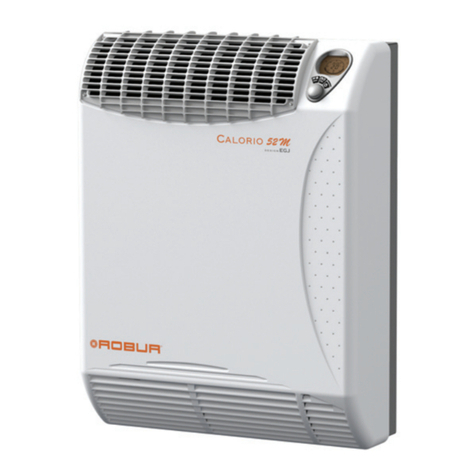
Robur
Robur Calorio M User manual
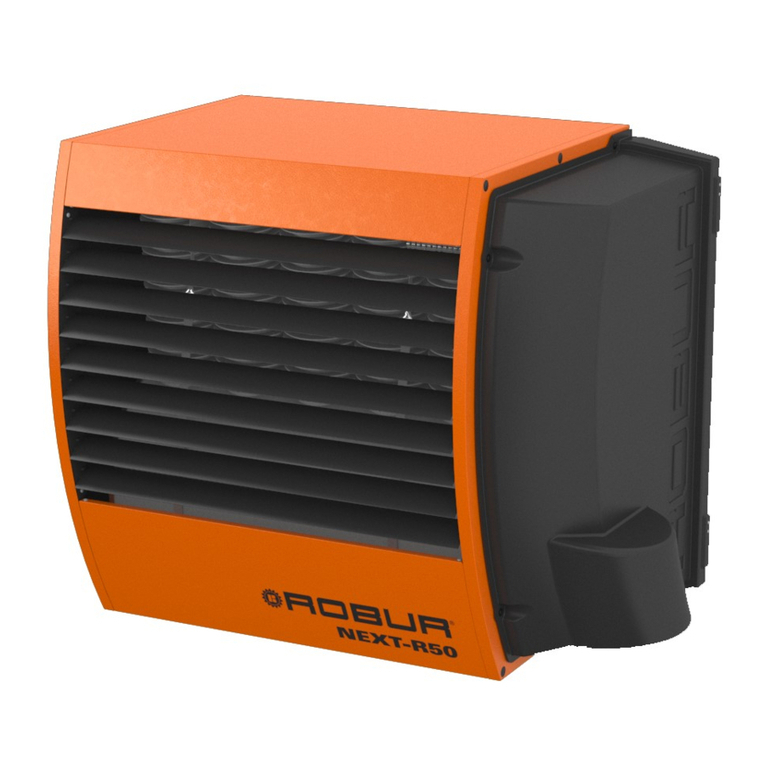
Robur
Robur Next-R Service manual

Robur
Robur Next-R User manual

Robur
Robur Heaters Line F2 C Series Service manual

Robur
Robur 5001 User manual

Robur
Robur Supercromo User manual
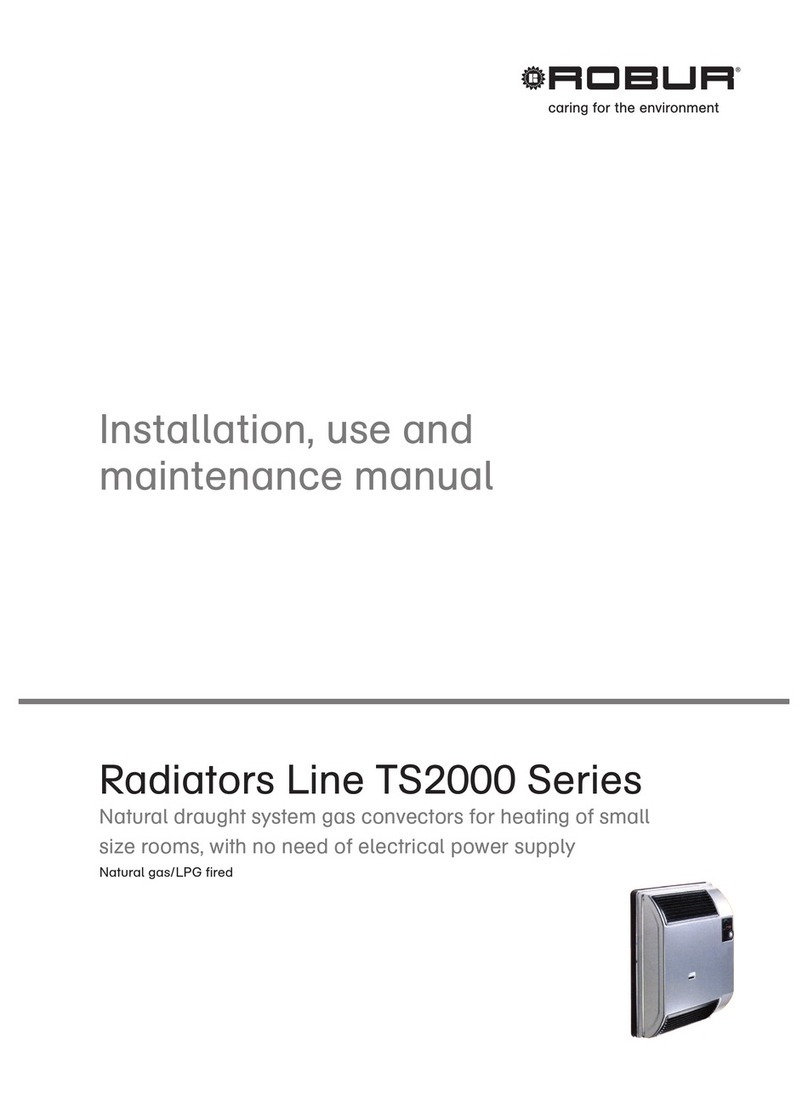
Robur
Robur TS2000 Series User manual
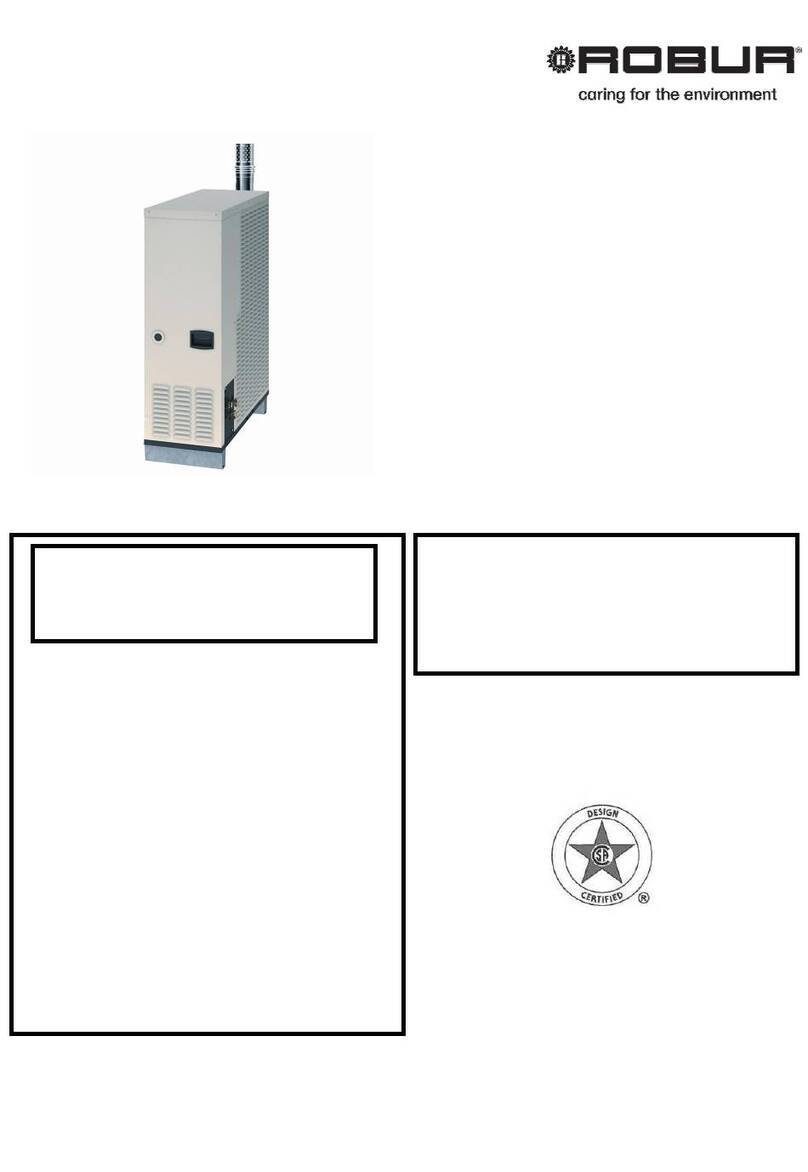
Robur
Robur AY00-119 Series User manual

Robur
Robur Supercromo D-LBR167 Quick start guide
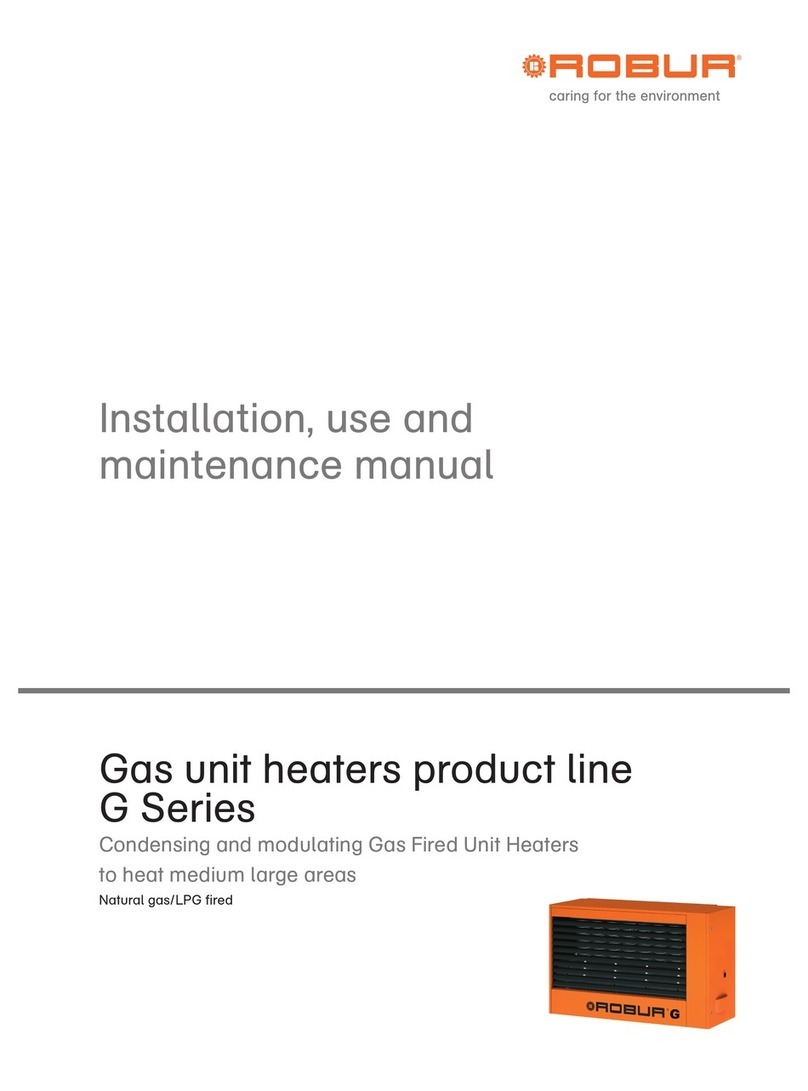
Robur
Robur G 30 Service manual


